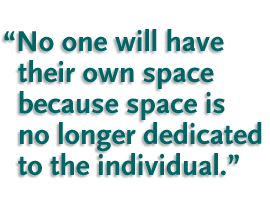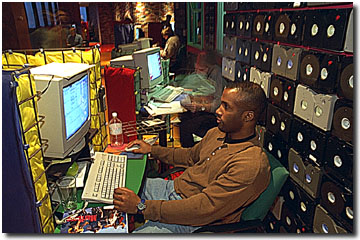 n the day the virtual office was unveiled at Chiat/Day advertising agency
in Los Angeles in 1994, nervous employees streamed in at 6:30 a.m., worried
they wouldn't find a place to sit. Or their old desk, for that matter. And they didn't.
In a bold move, founder Jay Chiat decided to replace the traditional office with a
radical new concept: the "nonoffice."
n the day the virtual office was unveiled at Chiat/Day advertising agency
in Los Angeles in 1994, nervous employees streamed in at 6:30 a.m., worried
they wouldn't find a place to sit. Or their old desk, for that matter. And they didn't.
In a bold move, founder Jay Chiat decided to replace the traditional office with a
radical new concept: the "nonoffice."
Personal space, that measuring stick of power, has been eliminated.
"No one will have their own space because space is no longer dedicated
to the individual," says Laurie Coots, business development director at Chiat/Day.
Instead, employees were greeted with the news that they could express
themselves in their lockers, which are more chic and spacious than high
school metal lockers. Cell phones are mandatory, and since much of the
modern-day office resides inside a computer, telephone jacks -- for modems --
and electrical outlets are ubiquitous. "The agency is designed around project rooms,"
writes Jay. "Each client has a room. It is the place where the information
on the client's business is assembled and shared. All this information is no
longer hoarded in the files of one or two people." Project rooms are electronically
linked to the library, where hard copy is scanned into a central database accessible to all.
Jay acknowledges that even now, two years later, many in business remain skeptical.
But he's convinced that a free-flowing virtual office, designed around technology,
is the look of the future. "Some of you may consider that possibility frightening,"
he says. "I can assure you that it's not. In fact, working in a virtual office is fun."
|







